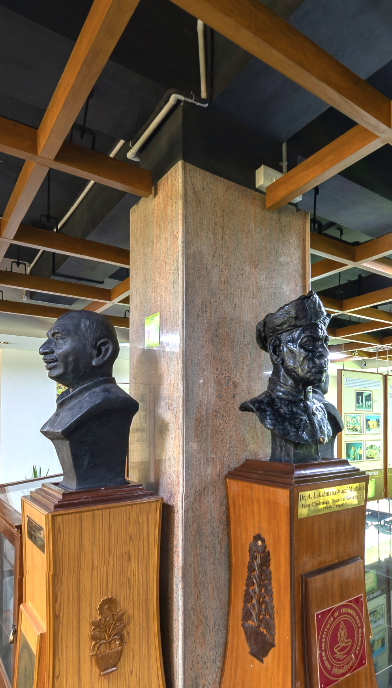Model of the S. V. University auditorium

- Photographs , Equipment , 1970s
The image describes a model of the Sri Venkateswara University (Tirupati) auditorium that was fabricated by the Department of Applied Mechanics at IIT Madras. The pressure distribution and the wind forces on the model were determined by tests in the 1.5m wind tunnel.
Differential thermal analysis and magnetic balance units
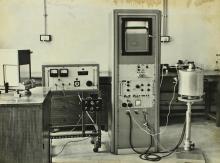
- Photographs , Equipment , 1970s
Seen in the image are differential thermal analysis and magnetic balance units photographed at the department of chemistry. The described units are used for following the thermal behaviour of materials and particularly to study phase transformations and chemical reactions. The upper limit of temperature is 1000° C and the rate of heating can be varied up to a maximum of 20° C per minute. The working range is -150° C to +100° C.
Foundation model tests
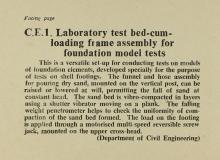
- Photographs , Equipment , 1970s
The foundation model tests are carried out using a versatile set-up for conducting tests on models of foundation elements, developed specially for the purpose of tests on shell footings. The image describes the set-up of this test that was done by the Department of Civil Engineering in IIT Madras. A funnel and hose assembly for pouring dry sand, mounted on the vertical post, can be raised or lowered at will, permitting consistent fall of sand. The sand bed is vibro –compacted in layers using a shutter vibrator moving on a plank. The falling weight penetrometer helps to check the uniformity of…
Four quadrant control for a D.C. motor (front view)
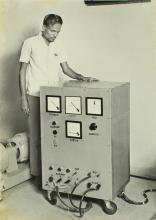
- Photographs , Equipment , 1970s
Seen in the image is the front view of a four quadrant control for a D.C. motor made at the Department of Electrical Engineering at IIT Madras. A four quadrant operation of a D.C. motor means that the machine works in 4 quadrants namely: Forward motoring, Forward Braking, Reverse motoring and Reverse braking as opposed to a motor that works in two modes: Motoring and Braking. Similar photographs can be found in album 0329: 001/0329/IMG_105831 & 001/0329/IMG_105834
Solar collector-cum-regenerator for air-conditioning
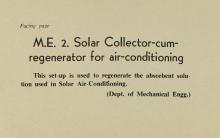
- Photographs , Equipment , 1970s
The description in the image refers to a solar collector-cum-regenerator that was built by the Department of Mechanical Engineering, IIT Madras. The set-up was used to regenerate the absorbent solution used in solar air-conditioning.
Model of a hyperbolic Paraboloidal shell footing (inside view)

- Photographs , Equipment , 1970s
The image depicts a model of a hyperbolic paraboloidal shell footing that was designed by the Department of Civil Engineering at IIT Madras. Hyperbolic paraboloidal shell footings are economic alternatives to plain footings in situations involving heavy column loads and weak soils. These footings are developed as precast foundations and installed using a special technique. Precast shell footings installed in this manner are particularly advantageous for industrial structures.
Ninth standard children in Kendriya Vidyalaya (IIT Campus) learn computer programming
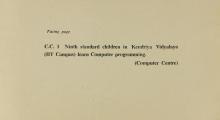
- Photographs , Equipment , 1970s
The image describes students (9th standard) learning Computer Programming at Kendriya Vidyalaya. The Kendriya Vidyalaya School is within the IIT Madras campus. It is possible that the students were photographed during a visit to the Computer Centre that is part of the campus. The Institute’s Computer Centre was inaugurated on 17th November 1973.
Four quadrant control for a D.C. motor
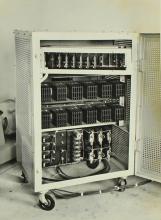
- Photographs , Equipment , 1970s
Seen in the image is the rear interior view of a four quadrant control for a D.C. motor made at the Department of Electrical Engineering at IIT Madras. A four quadrant operation of a D.C. motor means that the machine works in 4 quadrants namely: Forward motoring, Forward Braking, Reverse motoring and Reverse braking as opposed to a motor that works in two modes: Motoring and Braking. Similar images can be found in album 0329: 001/0329/IMG_105830 & 001/0329/IMG_105835
Total Exhaust Flow Smoke Meter for continuous measurement of smoke intensity in the exhaust of diesel engines
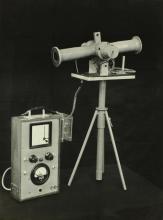
- Photographs , Equipment , 1970s
The total exhaust flow smoke meter is used for continuous measurement of smoke intensity in the exhaust of diesel engines. Seen in the image is a total exhaust flow smoke meter fabricated by the Department of Mechanical Engineering. The meter works in the following way: The instrument functions on the principle of light obstruction. A source of light is provided and a light beam crosses the exhaust flow of the engine. Depending on the concentration of smoke in the exhaust, a certain amount of light is absorbed. The light that passes through falls on a photo sensitive element. After…
Microwave Antenna (1.2 m diameter) fabricated at the FRP Centre
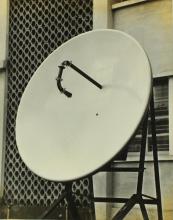
- Photographs , Equipment , 1970s
The image shows a microwave antenna that was developed at the FRP Centre. The FRP Centre was involvement in developing microwave antennas (0.5m, 1.2m and 3.3m diameters) that were imported by the Southern Railways. The Composite Structures (FRP) Research Centre, also known as the Fibre Reinforced Plastics (FRP) Centre was started at IIT Madras in March 1974. It was started due to the increased use of FRP, on a global scale, for advanced technology applications as well as for commercial and domestic applications. Prior to the formation of the Centre, in 1960, research and development…
Set-up for Holographic Interferometry
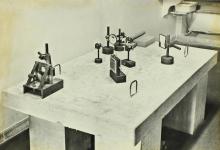
- Photographs , Equipment , 1970s
Holographic interferometry is a technique used for whole field displacement analysis and non-destructive testing. The image depicts a set-up for holographic interferometry that was conducted by the Department of Applied Mechanics. The setup is arranged on a vibration free concrete table top.
Relaxation test frame
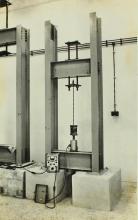
- Photographs , Equipment , 1970s
Relaxation is the loss of stress in a material kept under constant elongation. The image describes a self-straining unit developed by the Department of Civil Engineering, IIT Madras. A steel wire is kept stressed under a constant elongation and the decrease in stress with time, is measured with a tension load cell and manual compensating bridge. The uniqueness of this equipment lies in the constant elongation that is maintained with screws and nuts. The material used in the load cell for measuring strain does not possess any time dependent property.
Jig boring/jig grinding machine
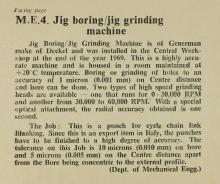
- Photographs , Equipment , 1970s
Jig-boring machines are used for boring, drilling, counter-sinking, reaming, milling, and other types of finishing in individual and small-scale production during the manufacture of cutting and measuring tools, jigs, dies, and key components of machines and instruments. A jig grinder is a machine tool used for grinding complex shapes and holes where the highest degrees of accuracy and finish are required. The image describes an interesting machine that is both a jig boring and jig grinding machine that is manufactured by a German company, Deckel. It was installed in the Central Workshop in…
Explosive forming set-up
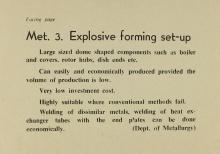
- Photographs , Equipment , 1970s
The image describes the benefits of the production technique ‘explosive forming’ that was used by the Department of Metallurgy at IIT Madras to fabricate certain components. Explosive forming is a technique used to form a metal plate using high shock pressure from an explosion. It is an ideal technique to use for producing large sized dome shaped components such as a boiler covers, rotor hubs, and dish ends etc. This method of production is economic as the volume of production is low. Welding of dissimilar metals, welding of heat exchange tubes with the end plates can also be done…
Solar water heater
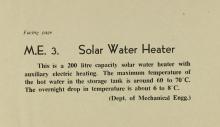
- Photographs , Equipment , 1970s
The description in the image refers to a solar water heater that was made by the Department of Mechanical Engineering. The water heater had the capacity of 200 litres with auxiliary electric heating. The maximum temperature of the hot water in the storage tank was around 60°C to 70°C. The overnight drop in temperature was observed to be 6°C to 8°C.
- Contribute
to the Centre -
Monetary
Support - Digital
Material

